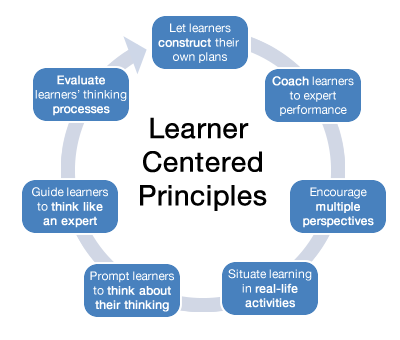 Learner-centered assessment methods personalize the learning outcomes by permitting mistakes and allowing students to learn from them.
Learner-centered assessment methods personalize the learning outcomes by permitting mistakes and allowing students to learn from them.
In learner-centered environments, teachers search to understand what students know and how they know it (Huba & Freed, 2000). Teaching, learning and assessment are all intertwined and ongoing, providing supportive guidance and timely and continual feedback in an environment that encourages risk-taking behavior, creative ideas, and experimentation with teamwork.
". . . people learn by confronting intriguing, beautiful, or important problems, authentic tasks that will challenge them to grapple with ideas, rethink their assumptions, and examine their mental models of reality. These are challenging yet supportive conditions in which learners feel a sense of control over their education; work collaboratively with others; believe that their work will be considered fairly and honestly; and try, fail, and receive feedback from expert learners in advance of and separate from any summative judgment of their effort.” — Bain (2004, p.18)
When students take ownership in learning, engagement improves (Weimer, 2013). Engaged learning occurs when students can collaboratively solve problems. People learn most effectively when they can make a substantial, positive impact on their own thoughts, actions and feelings, and those of others.
References:
-
Bain, K. (2004). What the best college teachers do. Cambridge, MA: Harvard University Press.
-
Huba, M. E., & Freed, J. E. (2000). Learner centered assessment on college campuses: Shifting the focus from teaching to learning. Community College Journal of Research and Practice, 24(9), 759-766.
-
Weimer, M. (2013), Learner-centered teaching: Five key changes to Practice, John Wiley & Sons.
Classroom Assessment Techniques (CATs)

Classroom Assessment Techniques (CATs) are a well-established, learner-centered approach to formative assessment that translate well to online courses. CATs are a set of techniques designed to find out more about what and how students are learning in order to better structure instruction and plan learning activities (Angelo and Cross).
CATs are very short classroom activities that typically provide a direct, formative and informal assessment—allowing instructors to see what students know and can do so they can make adjustments, without requiring time for assignment deadlines and grades.
Best Practices for CATs
CATs...
-
Are done and collected in a short time frame so that instructors can analyze the responses and provide feedback quickly.
-
Are ungraded, as the purpose is to provide information about student learning.
-
Are routine to assure effective communication and timely feedback.
-
Are brief to limit student time-on-task and instructor time-on-analysis and feedback..
-
Constitute both a learning activity and an assessment.
-
Stimulate metacognitive thinking—students reflecting on their own learning processes.
You may be familiar with the most popular approaches such as "muddiest point" or “one-minute paper” wherein each student writes a response so that the instructor can make adjustments to improve course design. The concepts behind CATs can be modified for online courses; while instructors may elect to assign points for the completion of the learning activity or use an online form, the core concepts translate well to all courses.
Optional Resources:
-
Short guide on CATs from the Vanderbilt Center for Teaching:
-
How to use CATs in online courses.
-
50 CATs by Angelo and Cross
To learn more: The Angelo and Cross monograph from which this approach originated remains very widely used, documents a wide range of CATs, and discusses the theoretical underpinnings in more depth.
Reference: Cross, K. P., & Angelo, T. A. (1993). Classroom assessment techniques: A handbook for college teachers. Ann Arbor, MI: National Center for Research to Improve Postsecondary Teaching and Learning, University of Michigan..
University of Wisconsin–Madison instructors discuss the importance of informal student feedback.
- Mark Edgar, Population Health Sciences, School of Medicine and Public Health
- Chris Dakes, School of Business & College of Engineering